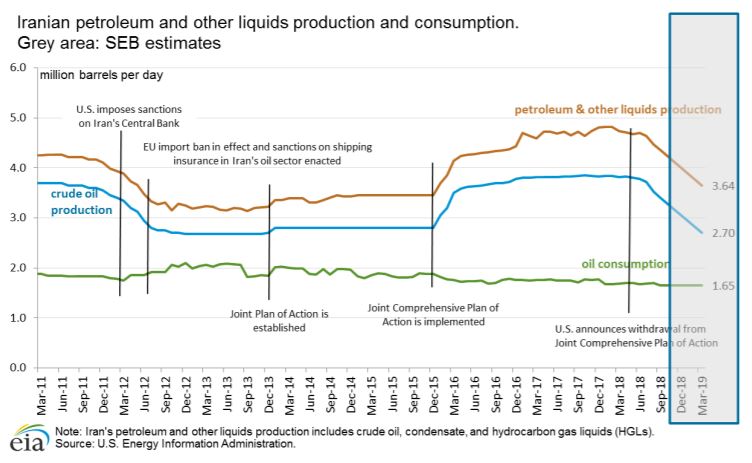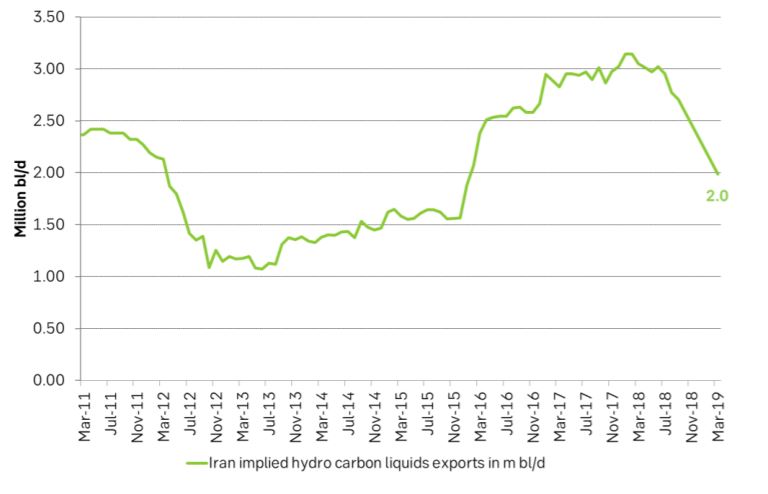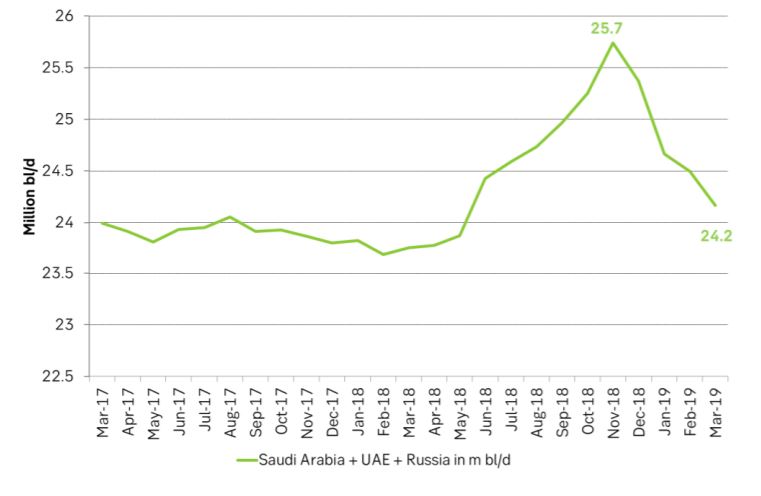Analys
Iran – Reactive Saudi means price will tick higher


Saudi Arabia pre-emptively and proactively lifted oil production last year in anticipation of US sanctions towards Iran. Sanctions were supposed to be more or less “cold turkey” starting November last year but Donald caved in and handed out a large portion of waivers. The result was that the pre-emptive production increase by OPEC+ last year instead managed to crash the oil price down to below $50/bl. Saudi Arabia is unlikely to make the same mistake again and is in our view likely to be reactive this time. First see how much oil supply is really lost and then increase production according to needs.
That means that the oil price is likely going to continue on its current bull-ride for a while before Saudi Arabia (++) decides to pitch in with substantially more production.

Iran probably exported about 2 m bl/d in March according to tanker tracker news. That is down 1 m bl/d from one year ago when they exported about 3.0 m bl/d liquids.
South Korea, India, Japan imported 0.75 m bl/d in March. They are likely going to comply fully so that their imports will likely fall to close to zero in May/June.
China imported 0.61 m bl/d in March versus waivers allowed by the US of 0.36 m bl/d. China has strongly opposed the US sanctions towards Iran: “The US is reaching beyond its jurisdiction” and “Our cooperation with Iran is open, transparent, lawful and legitimate”. We think that China can’t and won’t back down this time and that we could easily see an increase of Chinese oil imports from Iran up towards maybe 1.0 m bl/d
China Iran oil imports to increase and more Iran oil under the radar. There will also be an increasing amount of oil exports out of Iran which will go “under the sanctions radar”. This could probably amount to some 0.5 m bl/d and were probably already standing at around 0.3 m bl/d in March. So if China lifts imports from 0.6 m bl/d in March to instead 1.0 m bl/d and “under the radar” exports increase from 0.3 m bl/d in March to instead 0.5 m bl/d then Iran oil exports will continue at around 1.5 m bl/d versus around 2.0 m bl/d in March
Increasing collision course between the US and China. The “cold turkey” Iran sanctions from the US will force China to decide what to do, to hold its turf and claim its right to import oil from Iran. It will drive Iran closer to China and enable China to settle yet more oil in renminbi.
Russia is unlikely to hold back production in 2H-19. It reduced its production by some 0.2 m bl/d to 11.3 m bl/d in March in order to comply with the OPEC+ agreement from early December. It’ll probably lift production back up to 11.5 m bl/d in 2H-19 and then tick higher. It has been sensibly reluctant to pre-emptively promise to hold back production in 2H-19 and stated very clearly that it’ll manage production according to circumstances and that these circumstances will be evaluated when they meet with OPEC+ in Vienna in June 25/26.
Russian willingness to cut probably vanishes around $65/bl. Saudi Arabia would happily see the oil price back up at $85/bl. Russia’s willingness to cut in order to support the oil price probably vanishes around $65/bl. Russia is all-in joining Saudi Arabia on production cuts in times of surplus, rising stocks and Brent below $50/bl. It has however communicated very clearly that it is not all too eager to hold the oil price much above $65/bl as it will boost shale oil investments and production. That is alright as long as we are losing more and more supply from Iran and Venezuela. But what if those supplies come back into the market while US shale production growth is booming at the same time? Thus better to be safe than sorry and keep the oil price at around $65/bl and US shale oil activity at medium temperature.
The market will lose some 0.5 – 1.0 m bl/d. We cannot really know how much supply will now be lost from Iran. We don’t think it will go to zero but rather that exports will decline from 2.0 m bl/d in March to instead some 1.0 – 1.5 m bl/d along with increasing imports by China and “unknowns”. I.e. the market will lose some 0.5 – 1.0 m bl/d. OPEC+ can easily adjust for this. Saudi Arabia could actually do it alone.
Saudi Arabia (OPEC+) in very good control of the market. OPEC+ in general and Saudi Arabia specifically will have a very good handle of the supply situation of the oil market. I.e. Saudi will put current cuts partially back into the market and can then cut again at a later time instead.
John Bolton aiming for Iran regime shift. It has been stated that Donald Trump does not know what he want to achieve in the Middle East but that John Bolton does: a regime shift. The zero waivers is a victory for John Bolton’s politics. It increases the risk for turmoil in the Middle East.
A higher oil price is good for the US. Donald Trump has for a long time tried to aim for a low oil price in support of the US consumer and his core voters. His economic advisors have however this spring argued that a high oil price is now increasingly positive for the US economy as a whole as it is now increasingly becoming a net oil exporter. The negative for the consumers is increasingly outweighed by the positives for the oil producers. Thus Donald going for no waivers means that Donald is now increasingly siding with the producers rather than the consumers.
A more fragile oil market balance and yet more supply from the US. Less oil from Iran and a higher oil price means more US shale oil drilling and more supply growth from the US. But we are also getting a more fragile oil market. Supply from Venezuela continues to decline while supply from Libya and Nigeria is unstable as well.
Crude quality matters – IMO 2020 and diesel. Global oil supply is losing more and more medium to heavy sour crude oil which instead is largely replaced by ultralight US shale oil supply. The former is rich on medium to heavy molecule chains where the heavy chains can be converted to medium. The ultralight is rich on gasoline and light products which cannot be converted to medium elements. Medium elements mean Diesel, Gasoil and Jet fuel. Due to new fuel regulations in global shipping from 1 January 2020 the global shipping fleet will consume a lot more diesel/Gasoil like molecules. So less supply of diesel/Gasoil rich crudes but more demand means yet stronger mid-dist cracks.
Medium sour crude is typically the crude Saudi Arabia and OPEC and Russia. So if the world is craving for more Diesel, Gasoil and Jet fuel it is also craving for more of this crude. It means that Saudi Arabia and Russia (and OPEC) are in very good control of the oil market, even better than headline numbers indicate due to quality issues.
Ch1: Iran consumes some 1.7 m bl/d. In addition to 2.7 m bl/d of crude production in March 2019 it probably also produced some 0.95 m bl/d of condensates with total production of liquids of about 3.65 m bl/d. Exports thus probably stood at around 2.0 m bl/d in March which is also what tanker tracker data indicates. Exports are probably going to decline to about 1.0 to 1.5 m bl/d in May June

Ch2: Implied Iran hydro carbon liquids exports in m bl/d. US IEA data up to Sep 2018. Last data point estimated by SEB

Ch3: Saudi Arabia, UAE and Russia can easily lift production by 1.5 m bl/d

Analys
Tightening fundamentals – bullish inventories from DOE

The latest weekly report from the US DOE showed a substantial drawdown across key petroleum categories, adding more upside potential to the fundamental picture.

Commercial crude inventories (excl. SPR) fell by 5.8 million barrels, bringing total inventories down to 415.1 million barrels. Now sitting 11% below the five-year seasonal norm and placed in the lowest 2015-2022 range (see picture below).
Product inventories also tightened further last week. Gasoline inventories declined by 2.1 million barrels, with reductions seen in both finished gasoline and blending components. Current gasoline levels are about 3% below the five-year average for this time of year.
Among products, the most notable move came in diesel, where inventories dropped by almost 4.1 million barrels, deepening the deficit to around 20% below seasonal norms – continuing to underscore the persistent supply tightness in diesel markets.
The only area of inventory growth was in propane/propylene, which posted a significant 5.1-million-barrel build and now stands 9% above the five-year average.
Total commercial petroleum inventories (crude plus refined products) declined by 4.2 million barrels on the week, reinforcing the overall tightening of US crude and products.


Analys
Bombs to ”ceasefire” in hours – Brent below $70

A classic case of “buy the rumor, sell the news” played out in oil markets, as Brent crude has dropped sharply – down nearly USD 10 per barrel since yesterday evening – following Iran’s retaliatory strike on a U.S. air base in Qatar. The immediate reaction was: “That was it?” The strike followed a carefully calibrated, non-escalatory playbook, avoiding direct threats to energy infrastructure or disruption of shipping through the Strait of Hormuz – thus calming worst-case fears.

After Monday morning’s sharp spike to USD 81.4 per barrel, triggered by the U.S. bombing of Iranian nuclear facilities, oil prices drifted sideways in anticipation of a potential Iranian response. That response came with advance warning and caused limited physical damage. Early this morning, both the U.S. President and Iranian state media announced a ceasefire, effectively placing a lid on the immediate conflict risk – at least for now.
As a result, Brent crude has now fallen by a total of USD 12 from Monday’s peak, currently trading around USD 69 per barrel.
Looking beyond geopolitics, the market will now shift its focus to the upcoming OPEC+ meeting in early July. Saudi Arabia’s decision to increase output earlier this year – despite falling prices – has drawn renewed attention considering recent developments. Some suggest this was a response to U.S. pressure to offset potential Iranian supply losses.
However, consensus is that the move was driven more by internal OPEC+ dynamics. After years of curbing production to support prices, Riyadh had grown frustrated with quota-busting by several members (notably Kazakhstan). With Saudi Arabia cutting up to 2 million barrels per day – roughly 2% of global supply – returns were diminishing, and the risk of losing market share was rising. The production increase is widely seen as an effort to reassert leadership and restore discipline within the group.
That said, the FT recently stated that, the Saudis remain wary of past missteps. In 2018, Riyadh ramped up output at Trump’s request ahead of Iran sanctions, only to see prices collapse when the U.S. granted broad waivers – triggering oversupply. Officials have reportedly made it clear they don’t intend to repeat that mistake.
The recent visit by President Trump to Saudi Arabia, which included agreements on AI, defense, and nuclear cooperation, suggests a broader strategic alignment. This has fueled speculation about a quiet “pump-for-politics” deal behind recent production moves.
Looking ahead, oil prices have now retraced the entire rally sparked by the June 13 Israel–Iran escalation. This retreat provides more political and policy space for both the U.S. and Saudi Arabia. Specifically, it makes it easier for Riyadh to scale back its three recent production hikes of 411,000 barrels each, potentially returning to more moderate increases of 137,000 barrels for August and September.
In short: with no major loss of Iranian supply to the market, OPEC+ – led by Saudi Arabia – no longer needs to compensate for a disruption that hasn’t materialized, especially not to please the U.S. at the cost of its own market strategy. As the Saudis themselves have signaled, they are unlikely to repeat previous mistakes.
Conclusion: With Brent now in the high USD 60s, buying oil looks fundamentally justified. The geopolitical premium has deflated, but tensions between Israel and Iran remain unresolved – and the risk of missteps and renewed escalation still lingers. In fact, even this morning, reports have emerged of renewed missile fire despite the declared “truce.” The path forward may be calmer – but it is far from stable.
Analys
A muted price reaction. Market looks relaxed, but it is still on edge waiting for what Iran will do

Brent crossed the 80-line this morning but quickly fell back assigning limited probability for Iran choosing to close the Strait of Hormuz. Brent traded in a range of USD 70.56 – 79.04/b last week as the market fluctuated between ”Iran wants a deal” and ”US is about to attack Iran”. At the end of the week though, Donald Trump managed to convince markets (and probably also Iran) that he would make a decision within two weeks. I.e. no imminent attack. Previously when when he has talked about ”making a decision within two weeks” he has often ended up doing nothing in the end. The oil market relaxed as a result and the week ended at USD 77.01/b which is just USD 6/b above the year to date average of USD 71/b.

Brent jumped to USD 81.4/b this morning, the highest since mid-January, but then quickly fell back to a current price of USD 78.2/b which is only up 1.5% versus the close on Friday. As such the market is pricing a fairly low probability that Iran will actually close the Strait of Hormuz. Probably because it will hurt Iranian oil exports as well as the global oil market.
It was however all smoke and mirrors. Deception. The US attacked Iran on Saturday. The attack involved 125 warplanes, submarines and surface warships and 14 bunker buster bombs were dropped on Iranian nuclear sites including Fordow, Natanz and Isfahan. In response the Iranian Parliament voted in support of closing the Strait of Hormuz where some 17 mb of crude and products is transported to the global market every day plus significant volumes of LNG. This is however merely an advise to the Supreme leader Ayatollah Ali Khamenei and the Supreme National Security Council which sits with the final and actual decision.
No supply of oil is lost yet. It is about the risk of Iran closing the Strait of Hormuz or not. So far not a single drop of oil supply has been lost to the global market. The price at the moment is all about the assessed risk of loss of supply. Will Iran choose to choke of the Strait of Hormuz or not? That is the big question. It would be painful for US consumers, for Donald Trump’s voter base, for the global economy but also for Iran and its population which relies on oil exports and income from selling oil out of that Strait as well. As such it is not a no-brainer choice for Iran to close the Strait for oil exports. And looking at the il price this morning it is clear that the oil market doesn’t assign a very high probability of it happening. It is however probably well within the capability of Iran to close the Strait off with rockets, mines, air-drones and possibly sea-drones. Just look at how Ukraine has been able to control and damage the Russian Black Sea fleet.
What to do about the highly enriched uranium which has gone missing? While the US and Israel can celebrate their destruction of Iranian nuclear facilities they are also scratching their heads over what to do with the lost Iranian nuclear material. Iran had 408 kg of highly enriched uranium (IAEA). Almost weapons grade. Enough for some 10 nuclear warheads. It seems to have been transported out of Fordow before the attack this weekend.
The market is still on edge. USD 80-something/b seems sensible while we wait. The oil market reaction to this weekend’s events is very muted so far. The market is still on edge awaiting what Iran will do. Because Iran will do something. But what and when? An oil price of 80-something seems like a sensible level until something do happen.
-

 Nyheter3 veckor sedan
Nyheter3 veckor sedanStor uppsida i Lappland Guldprospekterings aktie enligt analys
-

 Nyheter4 veckor sedan
Nyheter4 veckor sedanBrookfield ska bygga ett AI-datacenter på hela 750 MW i Strängnäs
-

 Nyheter4 veckor sedan
Nyheter4 veckor sedanSommaren inleds med sol och varierande elpriser
-

 Nyheter3 veckor sedan
Nyheter3 veckor sedanSilverpriset släpar efter guldets utveckling, har mer uppsida
-

 Nyheter4 veckor sedan
Nyheter4 veckor sedanOPEC+ ökar oljeproduktionen trots fallande priser
-

 Analys4 veckor sedan
Analys4 veckor sedanBrent needs to fall to USD 58/b to make cheating unprofitable for Kazakhstan
-

 Nyheter4 veckor sedan
Nyheter4 veckor sedanTradingfirman XTX Markets bygger datacenter i finska Kajana för 1 miljard euro
-

 Nyheter2 veckor sedan
Nyheter2 veckor sedanUppgången i oljepriset planade ut under helgen









